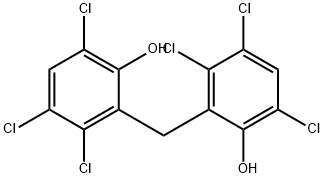헥사클로로펜 C화학적 특성, 용도, 생산
개요
Hexachlorophene (HCP) is a chlorinated bisphenol antiseptic
and was introduced for use as an antibacterial component in
drug and cosmetic products in 1941. It has bacteriostatic
activity against gram-positive organisms (e.g., staphylococcus)
but not against gram-negative organisms. HCP is readily
absorbed orally and through the skin of humans, especially
skin of premature infants or damaged skin. Hexachlorophene is
a neurotoxicant, and symptomology may include lethargy,
muscle weakness, irritability, cerebral edema, and paralysis
leading to coma and death. The US Food and Drug Administration
restricted the use of hexachlorophene preparation to
≤0.1% in 1972 and approved it for surgical scrubbing and
handwashing. HCP is no longer used extensively in hospitals,
rest homes, etc., because of its toxicity.
화학적 성질
Hexachlorophene is a crystalline solid com pound.
용도
Hexachlorophene is a topical antiseptic in germicidal soaps, creams, deodorants, cleansers, shampoos, after-shave creams, pHisoHex surgical cleanser and in veterinary medicine.
Indications
Hexachlorophene is a bacteriostatic antiseptic effective against gram-positive organisms,
specifically Staphylococcus. It has a cumulative and sustained effect. Although
it has a slow onset of action, with repeated use a film develops on the skin that
has long-acting properties. It is not effective against gram-negative organisms or
yeast. It is postulated to affect bacterial electron transport and membrane function.
With repeated use, it penetrates through the stratum corneum.
It is often used for
preoperative surgical scrubbing. One retrospective study showed that it may be
teratogenic if used excessively by pregnant women, although there have been no
subsequent, well-controlled studies that substantiate this. It should not be used in
infants, particularly those who are premature or have dermatoses. It is toxic to
tissues when applied to open wounds.
정의
ChEBI: An organochlorine compound that is diphenylmethane in which each of the phenyl groups is substituted by chlorines at positions 2, 3, and 5, and by a hydroxy group at position 6. An antiseptic that is effective against Gram-positive organisms, it is used in
soaps and creams for the treatment of various skin disorders. It is also used in agriculture as an acaricide and fungicide, but is not approved for such use within the European Union.
제조 방법
Hexachlorophene is formed by reaction of 2,4,5-trichlorophenol with paraformaldehyde in fuming sulfuric acid (20% SO3) at 65–135 ℃. Hexachlorophene is a strong bacteriostat which also has a microbicidal effect at high concentrations. The use of Hexachlorophene as an antimicrobial agent in cosmetics, medicinal soaps, detergent solutions, and textiles has, however, been discontinued because of its toxicity.
World Health Organization (WHO)
Hexachlorophene, an antimicrobial agent, was introduced in 1948
in proprietary liquid preparations and powders and was subsequently used
extensively as a topical antiseptic. By the early 1970s its use in infants had been
conclusively demonstrated to cause encephalopathy as a result of transdermal
absorption. More recently it has been suggested that the drug has a teratogenic
potential. Many regulatory authorities have placed rigorous restrictions on the
medicinal use of hexachlorophene, particularly in preparations intended for
infants. However, its use still commonly remains permissible at low concentrations
as a preservative in toiletries and cosmetics.
(Reference: (WHODI) WHO Drug Information, 3, 6, 1978)
일반 설명
A white free-flowing odorless powder. Insoluble in water and denser than water. Contact may irritate skin, eyes and mucous membranes. May be toxic by ingestion. Used to make other chemicals.
공기와 물의 반응
Insoluble in water.
반응 프로필
Hexachlorophene is incompatible with strong oxidizers. Hexachlorophene forms salts with alkalis and alkaline earths.
위험도
FDA prohibits use unless prescribed by a
physician. Questionable carcinogen.
건강위험
Inhalation of dust is poisonous; irritating to mucous membranes. Eye and skin irritant. Poisonous if swallowed. Symptoms following ingestion include anorexia, nausea, vomiting, abdominal cramps, and diarrhea. Dehydration may be severe and may be associated with shock.
잠재적 노출
HCP has been used as an antibacterial
agent in a wide variety of consumer products, including
soaps and deodorants; as a disinfectant. It has also been
used as an antifungal agent to treat various citrus fruits and
vegetables.
환경귀착
HCP adsorbs very strongly to soil and is not expected to leach to
groundwater. It may undergo slow photodegradation on the
surface of soils and water based on its absorption of light
(290 nm). No information is available on its biodegradation in
soil or surface water. HCP released in water adsorbs very strongly
to sediments and may bioconcentrate in aquatic organisms. It
has an estimated bioconcentration factor of 317 000. HCP is not
expected to hydrolyze or to significantly evaporate from water.
When released into the air, HCP is expected to be mainly in the
particle-sorbed state due to its low vapor pressure and high
estimated Koc. It is expected to be removed from the atmosphere
primarily by dry deposition, but it is also degraded by reaction
with photochemically produced hydroxyl radicals, with an
estimated vapor phase half-life of 2.5 days.
운송 방법
UN2875 Hexachlorophene, Hazard Class: 6.1;
Labels: 6.1-Poisonous materials.
Purification Methods
It forms needles from MeOH, C2H4Cl2, or toluene. The diacetate has m 175-176o (EtOH). A disinfectant is also available in MeOH (5mg/L). [Beilstein 6 III 5407, 6 IV 6659.]
비 호환성
Incompatible with oxidizers (chlorates,
nitrates, peroxides, permanganates, perchlorates, chlorine,
bromine, fluorine, etc.); contact may cause fires or explo sions. Keep away from alkaline materials, strong bases,
strong acids, oxoacids, epoxides.
폐기물 처리
Incineration, preferably
after mixing with another combustible fuel. Care must be
exercised to assure complete combustion to prevent the
formation of phosgene. An acid scrubber is necessary
to remove the halo acids produced. Consult with
environmental regulatory agencies for guidance on
acceptable disposal practices. Generators of waste con taining this contaminant (≥100 kg/mo) must conform to
EPA regulations governing storage, transportation, treat ment, and waste disposal.
헥사클로로펜 준비 용품 및 원자재
원자재
준비 용품








